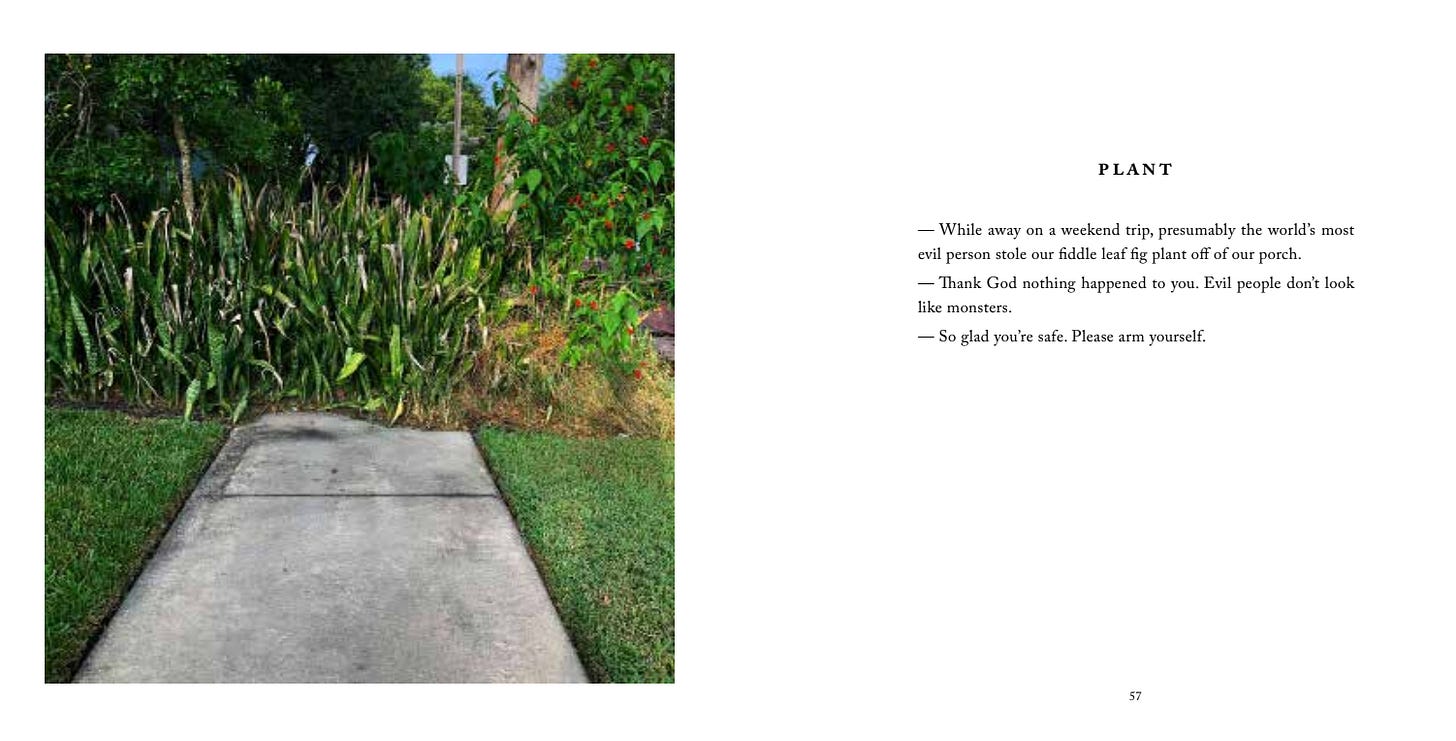Why You Want to Trade Your Non-Awesome Florida Neighbors for Plants
Published in late 2022, Nextdoor in Colonialtown is a book comprised of Nextdoor app posts and the author's photos. In reviewing it, Alex Gurtis lays out a case for Orlando as a microcosm of the USA.
In a state where history washes away with each storm, there are few structures that haven’t left with the latest king tide. Ryan Rivas, Florida legend, is one such structure. In 2010, he started Burrow Press, one of the state’s top independent literary presses and has continued to boost literature in a place where only the sun does shine. It was no surprise that when his debut book dropped in the Fall of 2022 it was bound to turn heads (and not because Florida legend and icon Kristen Arnett was part of the book launch at Will’s Pub.)
Next Door in Colonialtown collages snippets of conversations from the Nextdoor app and juxtaposes them against photos from the neighborhood to create a dark if not at times humorous take on whiteness, Florida gun culture, and how we view our neighbors. In Colonialtown, Rivas has written a book which is deeply rooted in a sense of place and yet feels universal.
One early standout piece is “A Lesson”, which is published alongside a photo of roadside piano. In it, a Nextdoor poster writes, “Called 911 for a noise complaint at 11:20 pm and it was normal level by 11:40 pm. - I just want to know what it is that motivated you to lodge this complaint. Thanks for making things a little harder for me. - If you want to play, be prepared to pay. I grew up knowing there were consequences for every bad action. Not enough kids are taught that today. -Please find out who reported you. Then find lawful ways to make them miserable. I mean go out of your way to give them other things to worry about. I know it sounds petty, but it’s really the only way to teach these people a lesson.” Anyone that has grown up in the Florida suburbs knows this culture of petty rage that hides like gnomes in manicured St. Augustine grass.
Rivas, who identifies as Latine and grew up in Miami, writes into this space with what feels like an Exacto blade of precision. A good example of this is the way he approaches gun violence in Florida. From the nationally known Pulse and Stoneman Douglas High School shootings to the almost daily report of “minor” shootings that only have two or three fatalities, Florida has been afflicted by the epidemic of gun violence. There is a gun problem in the state shaped like a gun and it is an ailment that can be partially traced back to a suburban culture that thinks firearms and anger can solve all issues. If a neighbor steals a fiddle leaf fig off your porch, “Please arm yourself” comes the ritualistic response.
Near downtown Orlando, Rivas’s Colonialtown North neighborhood was platted in 1911 by Developer H. Carl Dann. It’s “a place where your dollars will multiply while you sleep.” The name—Colonialtown North—projects the legacy of systemic racism that has plagued Florida since the arrival of the Spanish. In the 1920’s, segregation accelerated in Orlando and the Colonialtown developments displaced Jonestown, Orlando’s first Black community. Later Reeves Terrace, a then White-only public housing project was built in the 50s, which finalized the demise of Jonestown.
Many residents of Jonestown moved to Parramore on the east side of Division Avenue. Records show that some relocated to Griffin Park, a Black-only public housing development, which received national attention for the health issues of tenants partially being encircled by highway. In the late 50s, Interstate 4 was built adjacent to Division Avenue cementing a legacy of “otherness” for those that don’t identify as White. Further damage was done with the opening of the East-West expressway which again displaced at least “two hundred businesses [and] at least six-hundred renters” in Paramore. The highway around Griffin Park was mostly torn down as part of the I-4 Ultimate Project, although many residents still face health issues due to asbestos and other construction issues. There are no plans to relocate residents to safer living conditions at this time despite emerging plans to raze the development. Colonialtown North residents now identify as 73% White.
Colonialtown’s “Discord” captures this contradiction in a neighborhood that identifies as over 70% White, “-I found a free ‘newspaper’ in my driveway yesterday,” one poster writes. “Something seemed wrong as I looked through it. Some good information but it was all very biased. And very ‘White.’ Out of 180 photos, only four had a Black person visible. - Is it some type of weapon? - I don’t think there should be any separations. It causes discord. We are all humans and those who want to separate us into groups are desirous of policies that fly in the face of the constitution as well as Dr. MLK and any other person who ever fought against racism or segregation.” Cacophony follows attempts to keep Whiteness in the driver’s seat.
At times, readers may feel like the book’s minimalist content is stretching itself to fill space. The book is 83 pages, half of which are photos with a short contextual essay that serves as an afterword. But the book is like Seinfeld in that it provokes questions like, “Do you not have a conscience?” One could wonder if it was nothing more than a humorous tabletop book about absurd neighbors. However, that may very well be the point. Sparsity allows for these societal contradictions to sit on a pedestal and be critiqued without ornamentation. In challenging only the ethereal voices of Nextdoor, Rivas creates an astounding critique of what it means to live in suburban Orlando, Florida, and on a macro scale, America itself. Even as someone who loves living here, Nextdoor in Colonialtown will if nothing else make you laugh and admit you’d “gladly trade some of (your) non-awesome neighbors for plants.”






